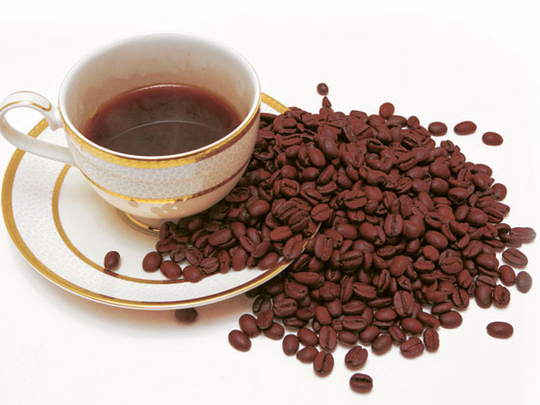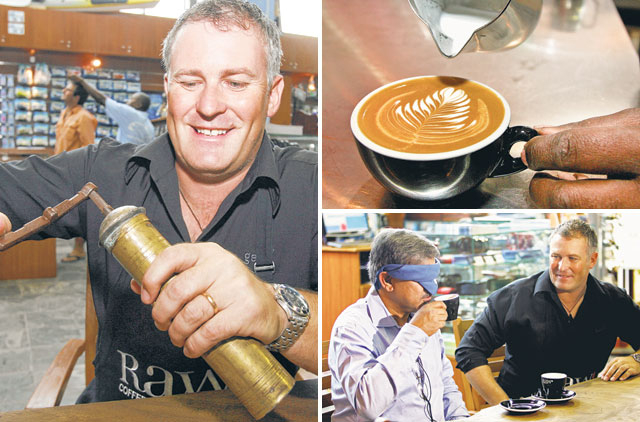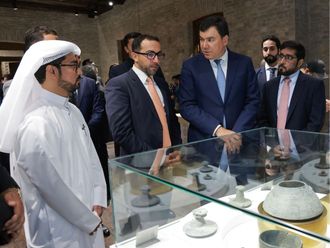
Dubai: For a beverage so widely consumed and enjoyed throughout the world, it is surprising how elusive a really good cup of coffee is. For the coffee lover the pursuit of the perfect espresso is even more difficult.
Espresso making is a fine art where the barista is but one in a chain of coffee experts among growers, buyers and roasters — to mention a few — who make the perfect cup possible.
The speciality coffee market in the UAE is still in its infancy and places where one can enjoy an excellent espresso few.
It was this market scenario that prompted Matt Toogood, a New Zealander who moved to Dubai a few years ago, to change course in his career and get into the coffee business.
A coffee enthusiast and amateur barista for over ten years, Toogood decided to become a professional. Now as Director of Raw Coffee Company, he is doing his bit for the coffee cause in the country, preparing excellent espresso at the same time.
"I think that the barista is really important and what a lot of companies try to do these days is to take the human element out of the equation. The end result of this an average cup of coffee but I know that when a professional barista makes me a cup, it will be very good. You can use the same beans, the same tamping…but it still is not the same. It's an art that can't be automated," says Toogood.
Brewing the perfect cup depends on several factors and these are not just to do with coffee. The time of day, the atmospheric pressure and the humidity all have a role to play. Meticulous attention is paid to every aspect of the process.
"We use large industrial grade grinders that can grind hundreds of cups of coffee a day but we put only as many beans as we use so we can keep the coffee as fresh as we can. At night we empty the hoppers out and put them away," he says.
Video: The art of making a perfect cup of coffee
A perfect balance
Raw Coffee selects organic certified fair trade Arabica beans from around the world, bringing together a balance of aroma, acidity, body and sweetness to create the perfect coffee.
"At the moment we use 12 different origins and we only roast by origin. Our blends can have several origins but we roast each origin individually then taste them and finally we blend them together. In some of the bigger companies they tend to blend the beans first and then do one roast."
Preparing espresso and espresso-based drinks consists of three main parts. These are extraction, milk texturing and pouring and cleaning. The extraction is the process in which the oils are pressured out of the roasted coffee grinds using hot water. The thick honey-like oil drips out of the handle and leaves a reddish brown crema on top of the espresso. This process takes approximately 20 to 30 seconds and yields a 30ml shot of espresso.
The main factors to control extraction are dose (the volume of grounds in the coffee handle), tamp (applying firm even pressure on the dose using a tamper) and grind.
In milk texturing, cold full-fat milk produces the best results, creating a smooth, creamy consistency with no visible bubbles. There are three parts to texturing milk. These are stretching, heat and pouring. Each of these are performed at the same time to offer an exquisite fern and other patterns on cappuccinos and lattes.
"We have a rule that the coffee should taste as good as it smells. It's really down to a personal preference. I love to interact with my customers and know what they want. Personally, I don't like milk in my coffee but 70 per cent of my customers drink heir coffee with milk. So what I try and do is develop a blend that I know the milk is going to go well with in the ristretto or macchiato, he says.
Grinding the beans
Speaking about the key steps in coffee making, he mentions that grinding is the most important part. "You'll get a fairly good cup of coffee even with an inexpensive machine at home if you have a good grinder. Many people spend a huge amount of money on the machine but they don't grind their own coffee. This is a waste of time. Invest in a good grinder then go for a good machine. I have customers who've brought grinders that cost three times the price of their machines and they tell me that they can't believe the difference it makes to the quality of their coffee."
The key is understanding what the coffee is going through in the roaster. After roasting, the coffee needs to rest for four days because the roasting process, produces carbon dioxide which gives a bubbly feeling in the mouth. "We find that our coffee is best seven to eight days after roasting and up to 21 days. Ground coffee can be kept in an airtight container in a dark place at room temperature for up to two months."
The aroma of fresh ground coffee that's what lost with time. In five minutes after grinding, 20 per cent of the aroma is lost.
"We constantly push ourselves to be better baristas and we enter competitions to keep learning and improve our knowledge and techniques," he says and adds that "the next big event coming up in Dubai is a barista competition that starts on the November 3 and is part of the Specialty Coffee Association. Hopefully we will get up to 40 competitors this year. Participants have 15 minutes to prepare 12 drinks for judges and are judged on technique and taste."
"Part of the reason I do this job is the feedback I get from people every day. You know they come here and say ‘wow that was different' and ‘why is this coffee better than the one down the road?' And I like to be able to tell people. I love to see the expressions on people's faces as they light up when they taste the coffee for the first time," he says.
Coffee types and coffee-growing regions of the world
Africa, South America and South East Asia are the main coffee producing areas. Africa and South America account for 95 per cent of the specialty coffee market. Arabica and Robusta are the two main coffee types and the latter is mainly grown in East Asia. To the coffee purist, Arabica is undoubtedly the preferred bean. The big difference and why the flavours are far more pronounced in Arabica beans is because Arabica has 44 chromosomes and Robusata has 22. Robusta has a naturally earthy taste and many European coffees use 20 per cent Robusta as a base.
“Though Robusta has good body we use only Arabica and can get the body out of it by using good roasting techniques. Typically I look for strictly high grown [over 2000 metres] Arabica coffee, as it has condensed the sugars inside that caramelise well when we roast [it],” Toogood says.
THE 5 STEPS TO BREWING AN ESPRESSO
Preparing espresso and espresso-based drinks consists of three main parts — extraction, milk texturing, pouring and cleaning. The extraction is the process in which the oils are pressured out of the roasted coffee grinds using hot water. The thick honey-like oil drips out of the handle and leaves a reddish brown crema on top of the espresso. This process takes approximately 20 to 30 seconds and yields a 30ml shot of espresso.
Methods of brewing coffee
Brewing fresh coffee should not be confused with preparing instant coffee. Instant coffee is produced by industrially brewing coffee and then spray drying or freeze drying it into a soluble powder, or granules, that is then dissolved in hot water.
There are four basic steps involved in preparing coffee. The coffee beans must be roasted (roasting), then the roasted beans must be ground (grinding), following which the ground coffee must be mixed with hot water for a certain period of time (brewing) and lastly the brewed coffee must be separated for the unwanted grounds.
There are several methods of brewing a fine cup of fresh coffee. It is for individuals to choose their preferred method based on their needs and unique preferences. It could be a strong mug of coffee for breakfast, an afternoon cappuccino or a dessert espresso. A few people prefer to roast and grind their own coffee, while others like to simply brew the beverage themselves.
The most popular home brewing methods include, drip coffee makers, cafetiere or French Press, stove top or electric percolator, boiling (as in preparing Turkish coffee), vacuum brewers or home espresso machines.
How to prepare a perfect cafetiere, or french press, coffee
Matt Toogood’s tips on how to prepare the perfect cup of steaming hot coffee...
- Preferably select fresh locally roasted coffee that has been roasted to a medium, not dark roast (city to full city level).
- If you do not have a grinder at home ask your roastery to grind your beans to a medium to coarse grind for filter but the preference is to grind your coffee beans just prior to preparing (Coffee that’s too finely ground won’t be caught by the filter efficiently, and you’ll end up with sediment in your cup).
- Remove the top and filter from the coffeemaker and ensure it is all clean.
- If the cafetiere is made from glass, pre heat the vessel and dry it thoroughly.
- Place coffee grounds in the coffeemaker. According to taste preference use. between 25 to 50 grammes (five tablespoons) of coffee to 1.4 L (1.1kg or 6 cups) of water and adjust to taste.
- Boil your water then let it cool for thirty seconds, the temperature of the water should be between 92-96 degrees Celsius .
- Gently pour the water. You can either pour just enough water into the cafetiere press to cover the grounds and stir gently (allowing the coffee to ‘bloom’ or create a foam, especially if the coffee is freshly ground) before adding the rest of the water, or pour all the water in at once.
- Let the coffee brew for approximately four minutes. Generally speaking, the coarser your grounds are, the longer your brew time should be but four minutes is about the longest you should ever need. Different coffees will need a different balance between coarseness of grind and brew time n Stir again just before compressing the plunger; this increases the body and flavour.
- Carefully press the filter down slowly, making sure the filter ‘spout’ is facing away from you.
- Wait 30 seconds for the grounds and thick sediment to settle to the bottom of the French press. Then, pour the coffee slowly into your cup to minimise the inclusion of fine sediment. Don’t let the coffee sit in the French press after the brewing time has completed, or else it can become bitter from remaining in contact with grounds for longer than needed.
Gulf News checks out how special is a specialty coffee.













